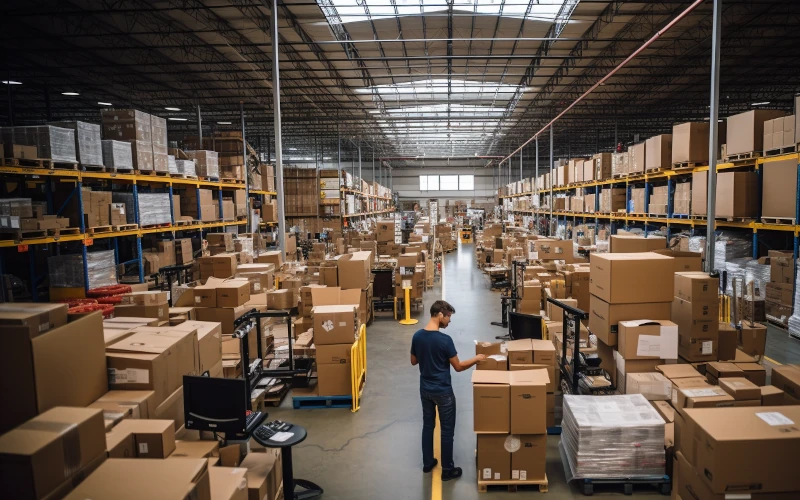Inventory 101: A Comprehensive Guide for Small Business Owners
August 21, 2023
The only advantage of trade is revenue increased and cost reduced. A company could make an inventory management system which can help increase revenue while lowering the cost of inventory.

And an effective inventory management system may let you decrease in-stock levels by 15 percent. You will work less, and you will make more.
Read on for a comprehensive guide to inventory management for small business owners.
Understanding Inventory Management
Managing inventory essentially means keeping an eye on who has what in stock, controlling sales, and keeping it all efficient. It's about knowing what to sell, and keeping the right amount of stock.
To manage your tins efficiently, it is important that you understand the different sorts of inventory that exist:
1. Raw Materials Inventory
Raw materials inventory is the raw materials or components used in the production of your product. Your raw materials inventory will depend on your industry. It could consist of fabrics, metals, plastics, or other material-specific components. For a small business, having enough raw materials is essential for the smooth functioning of your small business operations.
Forecasting your needs, keeping a constant supplier base and inventory management will help manage raw materials stock. Tracking and analyzing data on raw materials consumption and purchasing lead times on a daily basis will help you plan for shortages in advance. This will help to avoid production stalls and losing customers to your competitors due to product unavailability.
Regular assessments of suppliers
Another is to conduct regular assessments of your suppliers, getting quotes, gauging their reliability, and negotiating terms, to ensure that you buy at the best prices and maintain a healthy flow of inventory.
Furthermore, JIT inventory is another inventory control system that can be deployed to reduce waste by optimally managing raw materials.
2. Work-in-Progress (WIP) Inventory
WIP inventory refers to products that are being made or assembled but are not yet completed. For instance, it could be semi-finished products or partially assembled items. It Is important to check WIP inventory to see if there are any bottlenecks in a manufacturing process.
Ideally, visibility into your WIP inventory should be clear and accurate down to individual work cells. This is one reason why visual tracking boards are such an effective part of managing WIP inventory. Another approach is to use software-based project management tools, which often enable you to see the status of each WIP item in real-time.
3. Finished Goods Inventory
Finished goods inventory – which contains packaged products that are ready for sale – is maintained in your storage to be capable of supplying customer demands promptly. Well-managed stock level of finished goods inventory implies reaching the adequate level of stock to avoid overstocking or stockout.
As for your finished goods inventory, set reorder points and quantities that are informed by sales history, examples of successful inventory management, and demand forecasts. In this way, you can make sure you don't waste money on excess inventory.
Decentralized Inventory
With the help of a decentralized inventory distribution network or any other inventory management system such as technology-based automation tools, your finished goods inventory management can be greatly improved, as it allows you to have immediate inventory data, replenish quickly and keep track of your customers' orders.
4. Maintenance, Repair, and Operations (MRO) Inventory:
MRO inventory refers to all the goods ordered to sustain the day-to-day running of your company's offices, stores, and production facilities. These items could be office supplies, cleaning materials, tools or other goods that you normally use up in the course of running your business.
Tracking your MRO inventory will guarantee that the necessary supplies are available whenever they may be needed.
Properly managing MRO inventory requires a classification of items by their respective criticality and frequency of use. Generally, adopting a centralized procurement action of purchase, standardization of suppliers, better pricing, and less likelihood of stockouts.
Importance of CMMS
A computerized maintenance management system (CMMS) can also be used to manage your MRO inventory. A CMMS automates the maintenance scheduling process. It tracks inventory levels and tracks maintenance orders and backlog. Reports are generated to help you predict inventory demands and inventory levels so you can more effectively manage your MRO inventory to minimize downtime and improve the efficiency of all your operations, thus minimizing productive downtime.

Examples of Inventory Management in Small Businesses
-
Jane's Boutique:
Jane's Boutique makes designer items such as dresses, handbags, shoes, and coats. Any items made at the boutique are handcrafted. Jane monitors the inventory of raw materials she needs to make her clothes. This allows her to keep up with the amount of fabric, buttons and zippers she needs to create one of her dresses. If she is producing a lot of dresses, she needs to make sure that she has enough materials available. She also monitors the trends of her customers so she doesn't end up with unsold goods.
Jane's Boutique also incorporates a technology-enabled inventory management system that automates order processing, preventing stockouts and improving inventory visibility. Responding to her customers' sales patterns and customer preferences, Jane can make informed purchasing decisions, minimizing overbuying or underbuying.
-
Bob's Auto Repair:
Bob runs an auto repair shop that stocks both WIP and MRO inventory. That is, he stocks the spare parts and tools to repair and maintain his customers' vehicles. He keeps WIP inventory of items that are being used to maintain vehicles, so he knows what parts he has in stock, which he needs to order, and which are sitting idle. Further, keeping track of WIP for his auto repair shop allows him to know which immediately, thus improving his customers' experience.
VMI suppliers keep track of Bob's Auto Repair's inventory levels and automatically replenish stock Bob feels relieved that he no longer has to track stocking levels and reorder parts.
-
Sarah's Bakery:
Sarah runs a small bakery with a range of freshly baked goods on the shelves. Sales of her finished goods are tracked by Sarah who is aware of the sales and order rates to ensure minimum wastage. Customers are assured of getting their favorite pastries and bread weekly.
Sarah's Bakery uses a barcode scanning system to track in real time which items have been sold and which are still available, so Sarah can see what things are selling well and refill them as needed. This allows her to keep track of what is in the bakery, make sure that the ingredients she uses are still fresh, and increase efficiency in scheduling production and reducing waste.
Thanks to these small business owners' improvements in inventory management, their businesses have lower amounts of excess stock, lower holding costs, happier customers and higher sales.
Inventory 101 has helped you to identify all the different topics related to inventory in the best possible way. Understanding how to take charge of your list is the beginning of a good business, and this helps you do that. Track and manage the details of your inventory and maximize your returns with our help. Make sure your business succeeds with our help.
And for more tips and business advice, be sure to check out some of our other inventory management blog posts.
